Curiosity is back
Almost a month has passed since Curiosity came under the attack of cosmic charged particles and entered a safe mode. Most likely these were solar particles. because On the same day, Opportunity had problems with a computer, but it got off easier, although it is regrettable that all the world's attention was riveted on a curious "golden baby" and the marshes of the Martian "veteran" went unnoticed. But everything is over. Oppy completes the inspection of the Matievich Hill, and is increasingly looking to the south, where he will go this summer, and Curiosity successfully switched to managing the second computer, stretched his arm and set to work.

Performance to him returned gradually.
Two weeks ago, he sent the first photos in March.
To my surprise, these turned out to be frames, still for zero salt, from the MARDI camera. That is, the one that shot at 4 frames per second with the landing process since the moment of the heat shield separation. In a few minutes she took about three and a half thousand frames. One of those that captured the key landing moment turned out to be sent — when Sky Crane jets hit the surface of Mars.
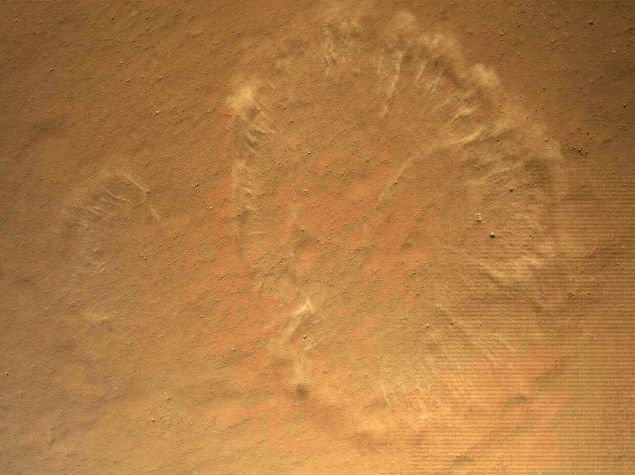
The rover was landing at an angle, so one track from the jet is larger than the other.
Full shooting process of landing (sound is not natural):
')
The reason why frames for zero-profit arrived only on the 215th was that the flight from Earth to Mars and landing were carried out on computer "B". While the work on Mars, before damage to the memory elements, was done on computer "A". That is, after the March brain transplant, the rover found only a few old frames in his memory and sent them. On the same day, he took some fresh photos with new cameras, but sent them only a week later.
Here it is necessary to explain where he got the "new" cameras. Curiosity has a total of 17 cameras. 4 of them are colored: two masted MastCams, one on the MAHLI manipulator, one MARDI for shooting shooting. In the first seconds on Mars, MARDI became so dusty that it is now hardly used. ChemCam is a black and white telescope camera equipped with a laser, it is used during spectrographic analyzes of the surrounding rocks or if it is necessary to consider something in detail without using a manipulator or on a manipulator.
The remaining cameras are used by engineers for orientation and control. Navigation NavCams installed on the "head" of the rover.
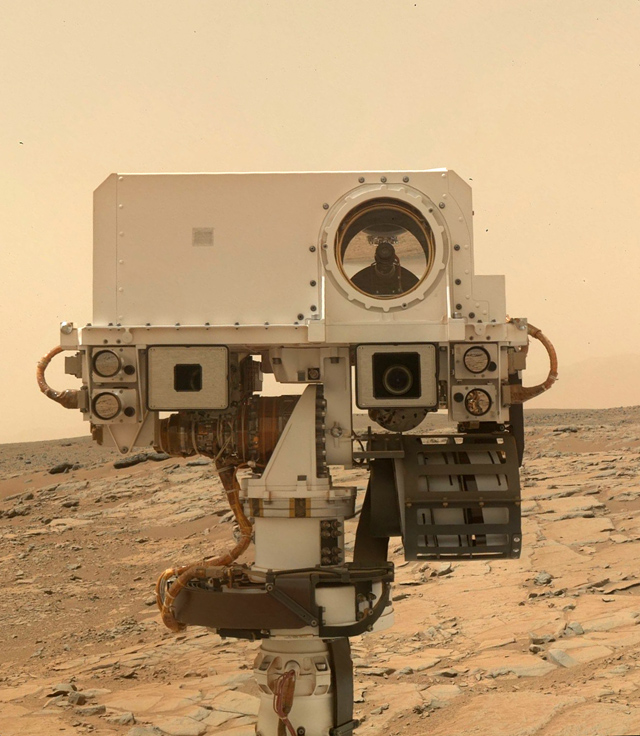
Their four lenses can be viewed from the sides of the MastCam rectangular eyepieces. NavCam is used as a pair to create a stereo image, according to which a special NASA program builds the landscape. This 3D model of Mars is used by rover drivers to assess the terrain, plan and implement movement.
In order to examine in detail the surface under the wheels of the rover, the HazCam hazard warning cameras are used. A total of eight pieces: four in front, four behind.
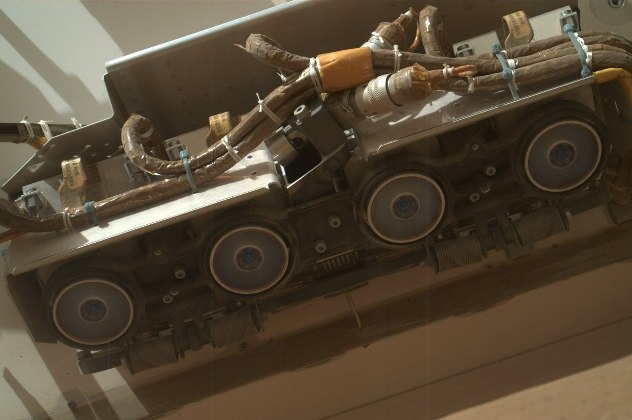
Now the whole secret of why cameras are filmed in stereo, i.e. used in pairs, and they are set to four pieces. The subtlety is that each of the two on-board computers of the rover manages its own set of cameras.
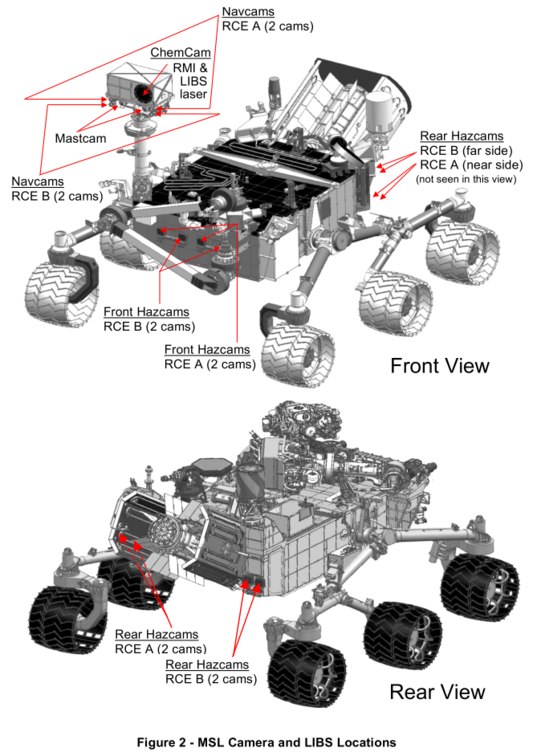
Accordingly, each camera in its name carries a computer designation, for example, “FHAZ_LEFT_A” - “front, hazcam, left, A” - front HazCam, left, computer “A”.
Since the new set of cameras is now being used, the “point of view” of the rover must change. The cameras have already been tested, so we can estimate how much the views on Mars have changed for Curiosity after the operation.
Vertical changes in navigation cameras:
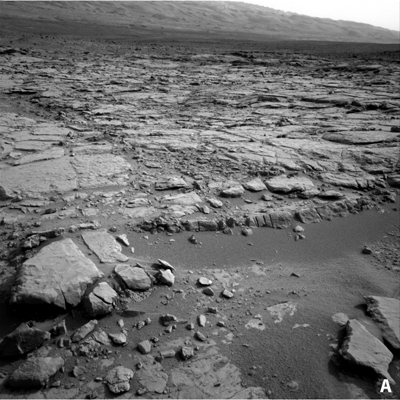
The front hazard warning camera shifts horizontally:
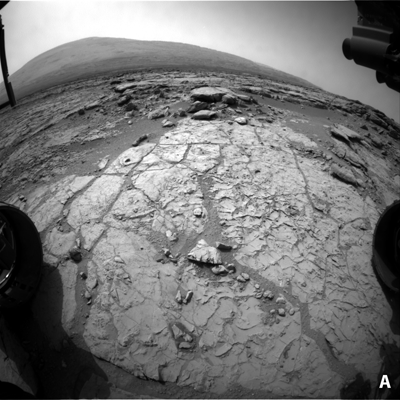
The left wheel changes position due to the high sphericity of the lens. HazCam - almost fish.
Rear Hazard Warning Camera:

As we see the most radical changes with the rear cameras - this is because they are not placed in one package, as in the front, but are separated by RTGs.
After the first photo shoot on the 215 sol rover again went into sleep mode due to an erroneous file, but stayed there only a couple of days. The bug was quickly identified, and at 222 sol, Curiosity had already returned to full-fledged life.
First of all he moved the manipulator.
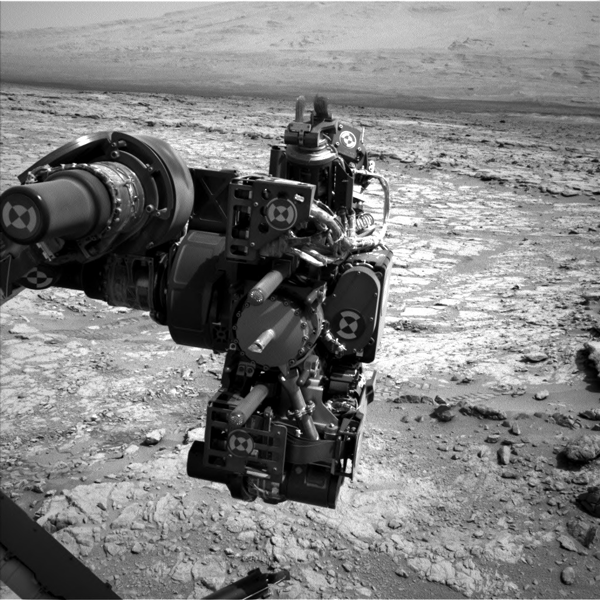
This was done in order to check whether the information about his position, which was loaded into it, exactly corresponds to the real state of affairs. After the warm-up, a panoramic survey of the area with navigation cameras was performed (at the beginning of the article).
The next day, Curiosity already sent color shots, and again surprised - they were over 200 sol.

Large format and desktop: vk.com
It was unexpected, but this is good news - it means that the operators got to the files in the memory of computer “A”, which he could not send because of the damage. That is, firstly: the scientific data is not damaged (or at least not all is damaged), secondly: access to the long-term memory of computer “A” is restored and, quite likely, the computer is fully operational again and will now perform the role of backup.
And at 225 Sol, Curiosity made new color shots, but not just a photograph of the terrain, but a series with which he usually accompanies the process of absorbing Martian soil with instruments in his body. It means that the study of interesting clay will be continued and it is possible to obtain any new scientific data or refined existing ones.
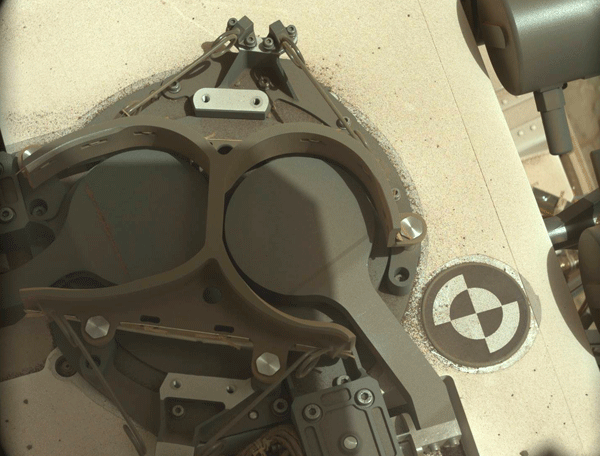
Here, monitoring of the lugs of the soil intakes was carried out before and after placing the sample inside. Judging by the fact that not a grain of sand is spilled, coordination has recovered perfectly.
Sample processing will take several more days. And there too, the solar overlap is not far off, and Curiosity will begin an independent life, at least for 3-4 weeks, as well as all Martian vehicles and one Venusian. Because of the Sun, the exchange of radio signals between the Earth, Mars and Venus will stop. Many devices have gone through this repeatedly, but Curiosity will be the first time. The overlap is repeated every 2 years.
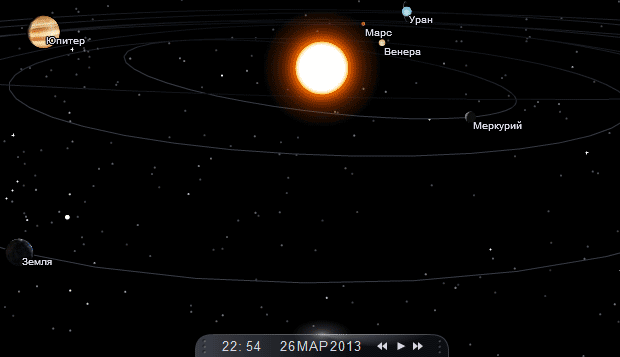
PS This material was prepared on the basis of raw photographic materials posted on the JPL website. The layout of the Curiosity cameras was created by enthusiasts of the US Planetary Community ; the animation of the solar system was created using the website solarsystemscope.com. Work on the text began before the publication of the official press release, and from there I only learned that the samples were loaded into the SAM device.
This is all I need to: even if NASA seriously reduces the costs of promoting its activities, we can handle it on our own, the main thing is that the RAWs will not stop spreading, but I am sure this will not happen.

Performance to him returned gradually.
Two weeks ago, he sent the first photos in March.
To my surprise, these turned out to be frames, still for zero salt, from the MARDI camera. That is, the one that shot at 4 frames per second with the landing process since the moment of the heat shield separation. In a few minutes she took about three and a half thousand frames. One of those that captured the key landing moment turned out to be sent — when Sky Crane jets hit the surface of Mars.

The rover was landing at an angle, so one track from the jet is larger than the other.
Full shooting process of landing (sound is not natural):
')
The reason why frames for zero-profit arrived only on the 215th was that the flight from Earth to Mars and landing were carried out on computer "B". While the work on Mars, before damage to the memory elements, was done on computer "A". That is, after the March brain transplant, the rover found only a few old frames in his memory and sent them. On the same day, he took some fresh photos with new cameras, but sent them only a week later.
Here it is necessary to explain where he got the "new" cameras. Curiosity has a total of 17 cameras. 4 of them are colored: two masted MastCams, one on the MAHLI manipulator, one MARDI for shooting shooting. In the first seconds on Mars, MARDI became so dusty that it is now hardly used. ChemCam is a black and white telescope camera equipped with a laser, it is used during spectrographic analyzes of the surrounding rocks or if it is necessary to consider something in detail without using a manipulator or on a manipulator.
The remaining cameras are used by engineers for orientation and control. Navigation NavCams installed on the "head" of the rover.

Their four lenses can be viewed from the sides of the MastCam rectangular eyepieces. NavCam is used as a pair to create a stereo image, according to which a special NASA program builds the landscape. This 3D model of Mars is used by rover drivers to assess the terrain, plan and implement movement.
In order to examine in detail the surface under the wheels of the rover, the HazCam hazard warning cameras are used. A total of eight pieces: four in front, four behind.

Now the whole secret of why cameras are filmed in stereo, i.e. used in pairs, and they are set to four pieces. The subtlety is that each of the two on-board computers of the rover manages its own set of cameras.

Accordingly, each camera in its name carries a computer designation, for example, “FHAZ_LEFT_A” - “front, hazcam, left, A” - front HazCam, left, computer “A”.
Since the new set of cameras is now being used, the “point of view” of the rover must change. The cameras have already been tested, so we can estimate how much the views on Mars have changed for Curiosity after the operation.
Vertical changes in navigation cameras:

The front hazard warning camera shifts horizontally:

The left wheel changes position due to the high sphericity of the lens. HazCam - almost fish.
Rear Hazard Warning Camera:

As we see the most radical changes with the rear cameras - this is because they are not placed in one package, as in the front, but are separated by RTGs.
After the first photo shoot on the 215 sol rover again went into sleep mode due to an erroneous file, but stayed there only a couple of days. The bug was quickly identified, and at 222 sol, Curiosity had already returned to full-fledged life.
First of all he moved the manipulator.

This was done in order to check whether the information about his position, which was loaded into it, exactly corresponds to the real state of affairs. After the warm-up, a panoramic survey of the area with navigation cameras was performed (at the beginning of the article).
The next day, Curiosity already sent color shots, and again surprised - they were over 200 sol.

Large format and desktop: vk.com
It was unexpected, but this is good news - it means that the operators got to the files in the memory of computer “A”, which he could not send because of the damage. That is, firstly: the scientific data is not damaged (or at least not all is damaged), secondly: access to the long-term memory of computer “A” is restored and, quite likely, the computer is fully operational again and will now perform the role of backup.
And at 225 Sol, Curiosity made new color shots, but not just a photograph of the terrain, but a series with which he usually accompanies the process of absorbing Martian soil with instruments in his body. It means that the study of interesting clay will be continued and it is possible to obtain any new scientific data or refined existing ones.

Here, monitoring of the lugs of the soil intakes was carried out before and after placing the sample inside. Judging by the fact that not a grain of sand is spilled, coordination has recovered perfectly.
Sample processing will take several more days. And there too, the solar overlap is not far off, and Curiosity will begin an independent life, at least for 3-4 weeks, as well as all Martian vehicles and one Venusian. Because of the Sun, the exchange of radio signals between the Earth, Mars and Venus will stop. Many devices have gone through this repeatedly, but Curiosity will be the first time. The overlap is repeated every 2 years.

PS This material was prepared on the basis of raw photographic materials posted on the JPL website. The layout of the Curiosity cameras was created by enthusiasts of the US Planetary Community ; the animation of the solar system was created using the website solarsystemscope.com. Work on the text began before the publication of the official press release, and from there I only learned that the samples were loaded into the SAM device.
This is all I need to: even if NASA seriously reduces the costs of promoting its activities, we can handle it on our own, the main thing is that the RAWs will not stop spreading, but I am sure this will not happen.
Source: https://habr.com/ru/post/174241/
All Articles